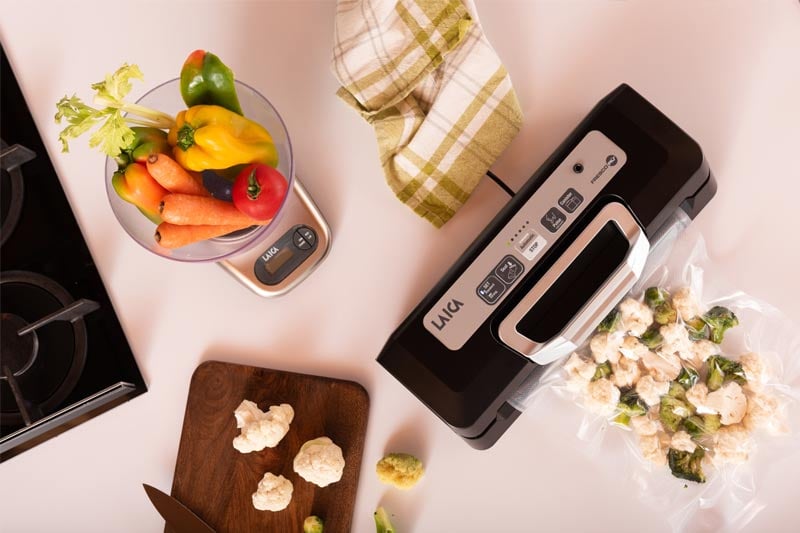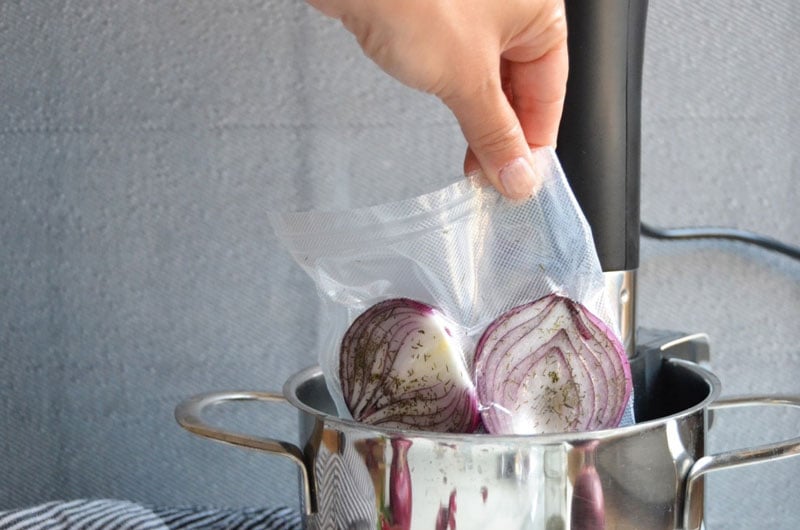Laica Blog
All the benefits of vacuum storage
The food vacuum storage technique ensures that the food's nutritional properties and flavour remain unaltered. By avoiding oxidisation, the food's 'lifespan' will be extended and its full flavour preserved. How is this possible?
Vacuum sealing, as the term itself implies, is a technique involving the creation of a vacuum around the food we want to preserve. A vacuum is defined as the removal of all air, and therefore also oxygen, from inside the storage container.
The oxygen, in fact, is what is responsible for food spoilage, oxidisation and bacterial growth over time. Using a machine that has this function, 'vacuum-packing' food prevents the food in the bag from deteriorating quickly, spoiling or undergoing sudden unpleasant changes in taste and flavour.
Food preserved through proper vacuum-packing will keep up to 5–6 times longer.
Benefits

The vacuum sealing technique is suitable for preserving many foodstuffs, both fresh and perfectly ripe, as well as cooked food. There are many benefits to food vacuum storage:
Reduces food waste
At the end of a lunch or dinner with friends, leftover food is often stored in the refrigerator, but you may not feel like eating the same dish the very next day. So unfortunately, even though we may keep them, leftovers are all too often thrown in the bin a few days later.
Vacuum sealing prolongs food's life, even when it has been cooked. Leftovers from a dinner party can be eaten later on when you feel like it, and waste will be greatly reduced.
Saves money
This aspect is often underestimated when people talk about food vacuum storage. It is actually one of the most important points. Being able to vacuum-pack food enables us to take a different approach when we go grocery shopping. We're not forced to buy only the food that we'll be able to use up in the next few hours, but we can think about buying larger quantities, as we know we can vacuum-pack some of it, thus saving a lot of money.
A simple ready-washed bag of lettuce can cost (per kilo) up to ten times more than a whole head. Having bought a head of lettuce, washed it and divided it into portions, vacuum-packing it is very easy and allows us to eat fresh salad for many days after our visit to the supermarket.
There is also a considerable economic advantage when it comes to cold cuts and meat, where the savings from buying larger quantities to slice at home can be as much as 50–60%.
Food safety
With its airtight seal (until reopened), food vacuum storage allows you to stack multiple food items on fridge shelves without them coming into contact with each other.
For those with allergies or intolerances, this is a considerable food safety advantage. Not only that, food that is vacuum-sealed will not come into contact with any spoilt food.
Convenience
Creating a vacuum to preserve fresh (or recently bought) foodstuffs is simple, very quick and, as we have seen so far, saves money.
The real convenience of this type of storage is that meals can also be planned and prepared in advance, then vacuum-packed and eaten during the week as if freshly made.
In everyday life, we don't always have the opportunity or the time for cooking while also being mindful of the quality of the food we bring to the table. Of course, though work commitments, children's school and sports activities, hobbies and housework are important elements in a day that should not be neglected, they still often make it difficult for us to take care of ourselves and, particularly, to eat fresh, quality food.
With vacuum sealing, we can, should we wish to, squeeze cooking time into a single day. It's simple, just choose what to cook and when you want to eat it. Having finished preparing the food, you can easily divide it into portions for use on set days, and even try out new cooking techniques, like Sous Vide, a method used in Michelin-starred restaurants.
What food can be stored
What are the most suitable food items for vacuum sealing?
As we've already seen, most kinds of food can be vacuum-preserved, but of course, the effects can also be very different according to each food's properties.
Bread
Let's start with a simple item like bread, which we buy every day from the bakery. Soft or crunchy, rolls or loaves, white or wholegrain; any type of bread left in the kitchen wrapped in its paper bag won't last more than two days (sometimes even less). After about 48 hours, it will be hard and impossible to chew (but excellent for grating, remember!).
Alternatively, instead of storing bakery bread in its original bag, we can use a food vacuum bag to remove all the air. This method can preserve the bread's aroma, taste, and softness for up to 7-8 days.
A significant difference that can boost our shopping budget!
Meat
When we purchase fresh meat from the butcher's shop and leave it in the fridge, it begins to spoil after just a few days. Although it may still be safe to eat, it won’t taste as good as it would have been if eaten on the day of purchase.
However, if we store the meat in a vacuum, its flavour and nutritional value will remain unchanged for up to a week.
Fish
Similar to meat, if we buy fish and simply put it in the fridge, we should eat it within 24 hours. Vacuum sealing will ensure it last about 5–6 days.
Just think of the convenience afforded by the flexible timing you get during the week as you balance work, home and family care commitments – food vacuum sealing is a precious tool in everyday life.

Cold cuts
Cold cuts are a category of food in which vacuum sealing can really make a big difference. Sliced meats can change colour and start to taste unpleasant quite quickly, even within a few hours, especially on very hot summer days.
If done correctly, vacuum sealing your cold cuts can assure a shelf life of between 4 and 6 months.
Cheese
Fresh cheese is delicious but equally susceptible to rapid spoilage. Using a food vacuum container means you can keep your fresh soft cheeses for up to two weeks.
If, on the other hand, you prefer the taste of aged cheeses, these can be vacuum sealed for up to 6 months.

Fruit and Vegetables
How many times have we seen crates of wonderful peaches or apples, but had to only take a few because we knew we could never eat that quantity in a short time?
With food vacuum storage, the shelf life of peaches, apples and apricots literally doubles.
This also applies to vegetables, which can be vacuum sealed either fresh, possibly chopped and separated, or cooked.
The convenience of vacuum storage, as we said before, is exactly in this facility to divide food into portions and small bags to be used later as needed.
For example, an apple can be stored whole or already peeled and cut into slices. These will not oxidise or change colour and, thanks to vacuum sealing, we can enjoy them several days later with their original taste and texture intact!
Something you may not be aware of
So far, we've talked about food vacuum technology as being useful for preserving, but something that is perhaps less well-known is how useful vacuum sealing can also be when marinating meat and fish.
When you marinate a steak or a slice of swordfish in a sealed, airless bag or container, it results in a more authentic and flavourful dish. This method allows the aromatic herbs to infuse the meat without compromising its quality.
Vacuum-sealed food can also be immersed in water and cooked at a low, constant and controlled temperature. Of course, this is known as Sous-Vide, a cooking method used in the finest restaurants, as it guarantees the food is cooked to perfection throughout.






It's your turn, leave your comment!
Get the latest from the Laica blog